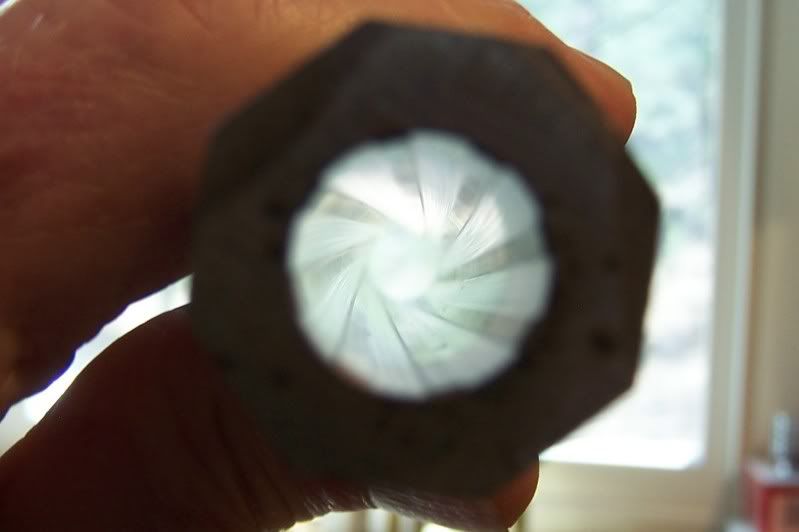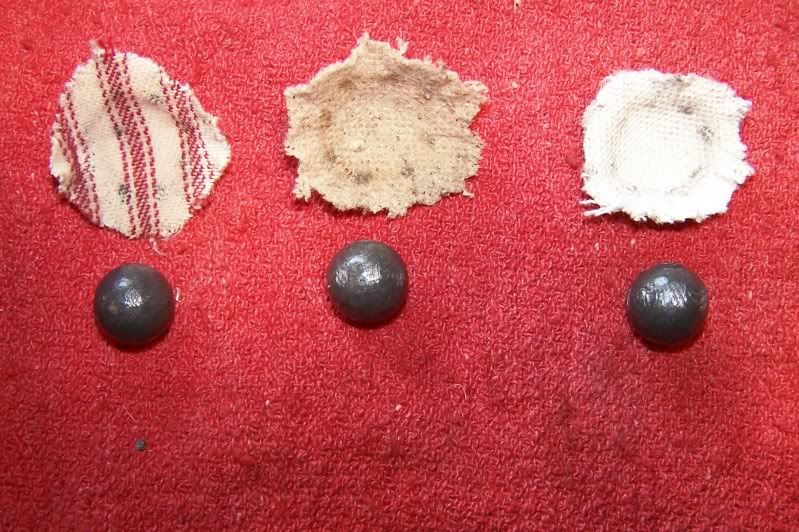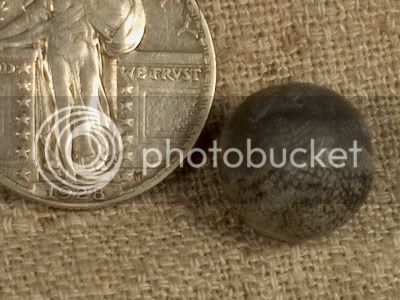The subject came up when someone mentioned that they had never seen rifling marks on recovered balls, whereas I have always seen them. So I decided to conduct a little test by just pushing patched balls through an 8" cut off rifle barrel. I'm not sure of the make of barrel, probably Green Mountain. It has 8 lands with grooves about .012" deep and somewhat wider than the lands. The first photo is of the bore.

I used Hornady swaged .490" balls with three different types and thicknesses of patching, all lubed lightly with deer tallow just to ease ramming them through the bore.
Here I might explain my method of measuring patch cloth thickness. I agree with Dutch Shultz that it is the compressed thickness which matters and some cloth compresses very much more easily than others. But after ruining a good micrometer by cranking it down hard as Dutch recommends I decided that was enough of that method. I now use my digital caliper, pressing the slide against the cloth just tightly enough so that when I release the pressure it will spring back one or two thousandths. I then record the "spring back" measurement as the thickness of that cloth. Lightly compressed with no damage to the instrument.
The first on the left is pillow ticking which by my method measures .016". This took only a light rap on the short starter, one could shoot this load all day without bruising the hand. The photo shows faint marks from the rifling, more visible in close examination than in the photo.
Next is cotton canvas which measures .027" and required several hard raps on the starter before cutting the patch. This is the kind of load I prefer for accuracy and shows distinct engraving of the lands.
Last is with .024" linen canvas. Linen does not compress nearly so much as cotton and even though this is thinner than the cotton canvas it definitely required a rawhide mallet to drive the ball starter enough to cut the patch and the nose of the ball was deformed by the concave tip of the ball starter. Here we see marks of the fabric pressed into the ball not only by the lands but even faint marks at the grooves.

Conclusions? Even a rather easy to load combination will show at least faint rifling marks on a soft lead ball.
Does obturation play a role? I think it does since recovered fired balls seem to show more distinct rifling marks than do the balls just rammed through a section of barrel. Also, some people report good accuracy with loads they can thumb start. I have to think their balls do obturate, else wise they would group like a smoothbore. Personally I've always found tighter loads to produce tighter groups.

I used Hornady swaged .490" balls with three different types and thicknesses of patching, all lubed lightly with deer tallow just to ease ramming them through the bore.
Here I might explain my method of measuring patch cloth thickness. I agree with Dutch Shultz that it is the compressed thickness which matters and some cloth compresses very much more easily than others. But after ruining a good micrometer by cranking it down hard as Dutch recommends I decided that was enough of that method. I now use my digital caliper, pressing the slide against the cloth just tightly enough so that when I release the pressure it will spring back one or two thousandths. I then record the "spring back" measurement as the thickness of that cloth. Lightly compressed with no damage to the instrument.
The first on the left is pillow ticking which by my method measures .016". This took only a light rap on the short starter, one could shoot this load all day without bruising the hand. The photo shows faint marks from the rifling, more visible in close examination than in the photo.
Next is cotton canvas which measures .027" and required several hard raps on the starter before cutting the patch. This is the kind of load I prefer for accuracy and shows distinct engraving of the lands.
Last is with .024" linen canvas. Linen does not compress nearly so much as cotton and even though this is thinner than the cotton canvas it definitely required a rawhide mallet to drive the ball starter enough to cut the patch and the nose of the ball was deformed by the concave tip of the ball starter. Here we see marks of the fabric pressed into the ball not only by the lands but even faint marks at the grooves.

Conclusions? Even a rather easy to load combination will show at least faint rifling marks on a soft lead ball.
Does obturation play a role? I think it does since recovered fired balls seem to show more distinct rifling marks than do the balls just rammed through a section of barrel. Also, some people report good accuracy with loads they can thumb start. I have to think their balls do obturate, else wise they would group like a smoothbore. Personally I've always found tighter loads to produce tighter groups.














